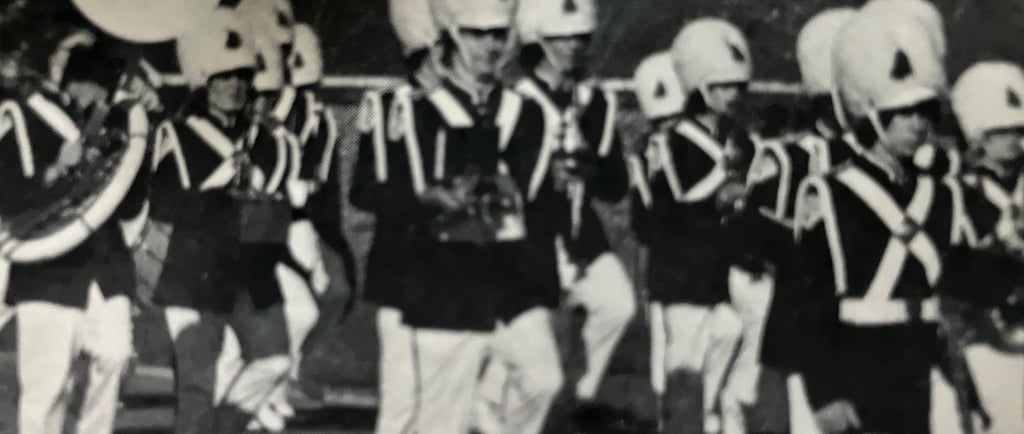Add your promotional text...
An Effective Leader is a Collaborative Steward
Leadership is not a Character trait. The be an effective leader requires character that comes from emotional learning brought on while taking the lead. Experience as a discriminating follower determines whether a leader can influence constituents. The principalship requires a delicate balance of empathy, humility, and expertise. This requires a willingness to learn from setbacks that will reward thoughtful risk taking in the future.
3/16/20254 min read


What it Takes to Lead
My Senior Year at Chattanooga High School was quite eventful. As the year began, I was Captain of the Band, running Cross Country, and looking, half-heartedly, at colleges. I felt no sense of urgency to pick a university. We were top of the heap. I was in no hurry to become a freshman again.
1977-1978 was the first year City High included 9th through 12th grade. This significantly changed the social dynamic as ninth graders were introduced to the more promiscuous behaviors of Seniors in an age when drinking was legal at 18. Very few seniors socialized with 9th graders, but in cases where they did, challenges arose.
________________________________________________________________________________________________
Due to white flight, the student population had dropped from around
2000 students in 1970 to 800 in the Spring of 1977.
City was also in a perceived decline driven by Southern racism. My three years at City were peaceful for the most part. Black and white students got along in classes, athletics, and beyond. Due to white flight, the student population had dropped from around 2000 students in 1970 to 800 in the Spring of 1977. City’s building was meant for a larger population, so Chattanooga decided to add 9th grade to hit the 1000 threshold. Our depopulation impacted everything from resource depletion to staff attrition.
Hubris meets Humility
Our band was small, and our director struggled to get recruits. We had some talented musicians, but on the field, we just didn’t have the size to produce big half time performances. We were all frustrated and this experience represented my first meaningful leadership failure. The band officers of the two previous years all behaved too aggressively toward the rest of the band to impose misplaced authority. I made similar mistakes. It didn’t help that I was openly disdainful toward the band director, as were others, because circumstances beyond her control kept us from what we thought to be excellence. When I should have worked with her I didn’t.
________________________)_______________________________________________________________________
It was a hard experience but having gone through it at that stage of growing
up helped me in my leadership opportunities later in life.
During my career I often reflected on my band experience and looked at my mistakes as an example of how not to treat my charges if I wanted to get results. It was a hard experience but having gone through it at that stage of growing up helped me in my leadership opportunities later in life.
There were other challenges that made my Senior year uncomfortable. After a promising Junior year in Cross-Country and Track, I didn’t improve as I expected my Senior year. I got a late start for a runner and didn’t understand the importance of mileage or how to take advantage of North Chattanooga’s hilly terrain in my training. I thought natural talent would get me there and I later discovered that natural ability wasn’t my strength. What I learned but didn’t know then would play a significant role in what success I would have as a coach. So, like most high schoolers, my failures provided significant lessons for later in life.
Goals Lead to a Calling
When I started teaching, my goal was to get to high school to teach and coach track and cross-country. I taught in a junior high school for 13 years before getting to high school. I hadn’t totally given up on my political interests and after the publication of “A Nation at Risk” by the Reagan administration I actively looked for opportunities to be a public-school advocate. My first opportunity came with the Teaching Learning Center of the Charlotte-Mecklenburg Schools. When I discovered this organization, I found a group of like-minded progressive educators who saw the opportunity to address the new calls for school reform with teacher centered solutions.
______________________________________________________________________________________________
We ended up putting together a workshop that trained people to work from
a facilitation model loosely related to W. Edward Deming’s
“Total Quality Management.”
I had the privilege of working with the two leaders of the organization, Recardo Sockwell and Carol Newman, who shared a passion for classroom generated change. We ended up putting together a workshop that trained people to work from a facilitation model loosely related to W. Edward Deming’s “Total Quality Management.” We spent a year designing this class and recruiting participants that included teachers, administrators, interested parents, and businesspeople. We had teachers bring problems they faced in their classrooms and put them before groups with diverse backgrounds who helped develop remedies. I learned a great deal about organizational practice through this experience and applied this process in my later roles as a school leader.
As we worked on this project, the concept of Site Based Management was being explored by the district and my school was selected as one of the model sites. I was appointed co-chair. Our efforts were not successful. The principal at the time was skeptical and unwilling to allow our teacher cohort to drive school policy solutions. I believed that true changes in school culture could not take place without teacher initiative and input. It was hard to find a principal who had the confidence to let this happen. My work with the Teaching Learning Center experience helped me see the challenges of meaningful change when public-school management tended to be top down and rigid.
It's About the Followers
As I wrote earlier, I entered teaching to teach and coach. As a teacher I wasn’t afraid to speak up, but I had little desire to step into administration early in my career. I find it ironic that one of the individuals who asked me to consider school leadership was the same principal I challenged through our site-based management committee.
________________________________________________________________________________________________
Leadership within a schoolhouse is multifaceted.
Leadership is not a character trait, but a skill set. The opportunity to lead in a high school with challenges as a teacher set the stage for my future in education. Leadership within a schoolhouse is multifaceted. There is the formal hierarchy established through the principal, the institutional influencers made of experienced staff with perceived expertise, and the cultural cohort that can create tension among school constituencies if not heard. Although the principal has official authority, it is how a principal nurtures the culture of the school that determines efficacy. I learned that nurturing discriminating followers is crucial for a school’s success. If a principal does this well, a collaborative stewardship among the school staff becomes a habit that promotes academic growth.
©Paul A. Bonner
